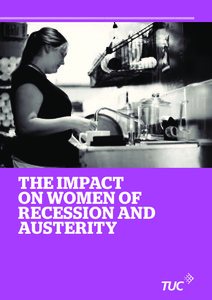The impact on women of recession and austerity
"This report, prepared for TUC Women’s Conference 2015, takes stock and looks at how women have fared through recession and austerity. It finds that while progress on some headline measures of gender equality has continued – the employment and pay gap have continued to narrow, for example – som...
| Institution: | ETUI-European Trade Union Institute |
|---|---|
| Format: | TEXT |
| Language: | English |
| Published: |
London
2015
TUC |
| Subjects: | |
| Online Access: | https://www.labourline.org/KENTIKA-19114959124919321319-The-impact-on-women-of-recessi.htm |
| Summary: | "This report, prepared for TUC Women’s Conference 2015, takes stock and looks at how women have fared through recession and austerity. It finds that while progress on some headline measures of gender equality has continued – the employment and pay gap have continued to narrow, for example – some women are facing new hardships and barriers to equality.
- The number of women in work is greater than ever before but young women’s employment, which fell furthest in the recession years, has still not recovered.
- There has been a rise in the number of women who are stuck on zerohours and short-hours contracts unable to get enough work to make ends meet and afraid to complain in case they lose the hours that they do have.
- Pay in real terms has fallen for women even though it hasn’t fallen by as much as for men.
- Women working full-time now earn about nine per cent less per hour than men but women working part-time earn nearly 38 per cent less.
- They still make up the majority of those paid less than the living wage and more women than ever before are in part-time work because they can’t find full-time work.
- Single mothers face greater obligations to look for work and are at greater risk of having their benefits taken away. They are also the group most likely to be sanctioned for unjustifiable reasons. More single mothers are now in work but frequently they are stuck in low-skilled and low-paid jobs which they have little chance of progressing from.
These are just some of the findings of this report. It is intended to shine a light on how women have been affected by the changes to the labour market and the cuts in public spending in the past seven years and to help trade unions prioritise action to defend the most vulnerable women in the workplace and society." |
|---|---|
| Physical Description: | 28 p. Digital |

